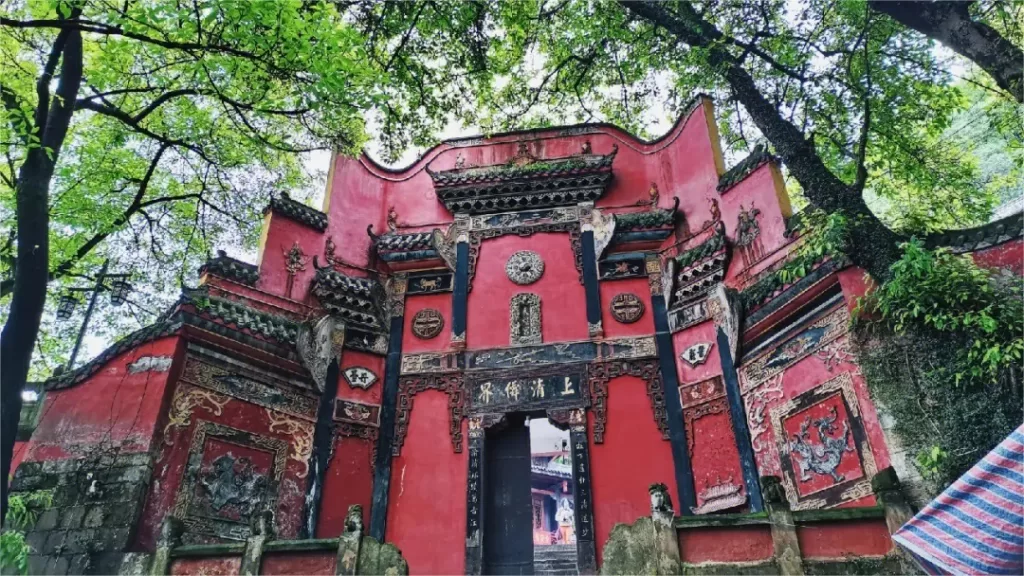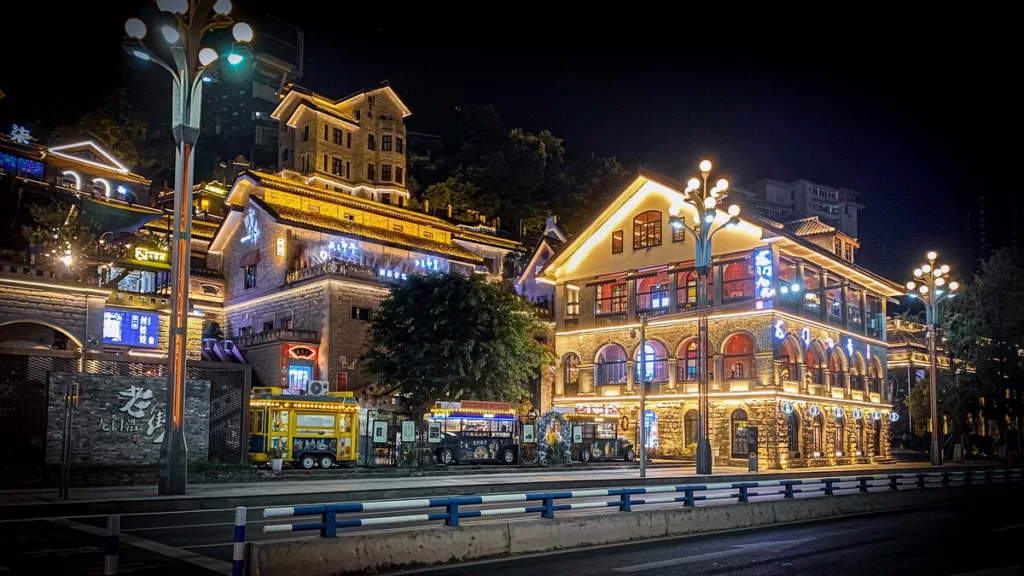Nanshan Botanical Garden (南山植物园), nestled in the picturesque landscapes of Chongqing, stands at an elevation ranging from 420 to 680.5 meters. Encompassing a sprawling area of 551 hectares, it’s a veritable paradise for plant enthusiasts and nature lovers alike. This sanctuary specializes in preserving and cultivating the rich biodiversity of subtropical low-mountain plants native to China.
At its heart lies an exquisite collection of 1,646 plant species, meticulously curated from both domestic and international sources. The garden’s greenhouse shelters a stunning array of flora, organized into distinct sections based on their places of origin. Visitors can explore the Tropical Rainforest Zone, home to 532 species spanning 105 families and 253 genera, the Four Seasons Flower Zone with 223 species from 46 families and 100 genera, the Subalpine Plant Zone harboring 261 species across 76 families and 141 genera, and the Succulent Zone featuring 630 species from 18 families and 70 genera.
Nanshan Botanical Garden offers a fascinating glimpse into the diverse and vibrant world of botanical wonders in the heart of Chongqing.
Table of Contents
- Basic Information
- Location and Transportation
- Highlights of the Botanical Garden
- Video about Nanshan Botanical Garden
- Useful Tips Summarized from Reviews
- Attractions near Nanshan Botanical Garden
Basic Information
| Website | http://www.cqnsbg.cn/ |
| Estimated Length of Tour | 3 hours |
| Ticket Price | 30 RMB without the greenhouse 50 RMB including the greenhouse |
| Opening Hours | 9.00 – 17.30; Last admission: 17.00 |
| Reputation | AAAA Tourist Attraction |
| Telephone Number | 0086-023-62479135 0086-023-62479564 |
Location and Transportation
Nanshan Botanical Garden is situated at 101 Nanshan Botanical Garden Road, Nanan District, Chongqing, China. It boasts a prime location, offering breathtaking views of the Chongqing cityscape across the river. This verdant oasis is conveniently located just 15 kilometers away from the city center. Its geographical coordinates are approximately 106.63677° East longitude and 29.5610° North latitude.
Tourists can take Bus No. 335, 337, or 384 and get off at Nanshan Stop (南山站) to reach the west gate of the botanical garden. Unfortunately, there is no metro station nearby.
Highlights of the Botanical Garden
Multiflora Rose Garden

The Multiflora Rose Garden is nestled in the heart of Nanshan Botanical Garden in Chongqing. Encompassing an area of 176 acres, this exquisite garden is a true floral paradise, featuring an abundant array of cherry blossoms, crabapples, magnolias, and other renowned flowers and exotic plants. Serving as a dedicated showcase for the Rosaceae family of plants, the garden has painstakingly introduced over 180 species and more than 60,000 individual plants from various regions. From March to May each year, the Multiflora Rose Garden bursts into vibrant hues of pink and red, resembling a breathtaking sea of blossoms.
Orchid Garden

The Orchid Garden at Nanshan Botanical Garden is a serene oasis spanning over 30 acres. Originally established by renovating and expanding the pre-existing Orchid Garden within Nanshan Park, it opened its doors to visitors in February 2001. The garden boasts a collection of over 3,000 orchids, including a diverse range of species such as Spring Orchids, Ink Orchids, Sword Orchids, Tiger Orchids, and Large-flowered Hui Orchids, totaling more than 20 varieties. Among its attractions, you’ll find historical landmarks like the Spanish Villa from the wartime era, the fragrant “Wang Zhe Xiang,” as well as picturesque elements like stone-pillared corridors, bamboo-crafted pavilions, babbling brooks, and rock formations, all harmoniously blending with the environment to evoke the rich cultural essence of Eastern Sichuan gardens.
Endangered Species Garden

The Endangered Species Garden within Nanshan Botanical Garden is a poignant tribute to the world’s rare and endangered plant species. This garden showcases a remarkable collection of 42 of the planet’s most precious and imperiled plants, complemented by the establishment of a cemetery dedicated to extinct and critically endangered species. Additionally, it actively participates in conservation efforts by introducing and safeguarding various endangered plants such as the Hammer Trees, Southern Hemlocks, Chinese Yews, Yichang Oranges, Xiangguo Trees, Lianxiang Trees, and Min Nan Trees, among others. This garden serves as a vital reminder of the importance of preserving and protecting Earth’s fragile botanical treasures.
Camellia Tea Garden

The Camellia Tea Garden at Nanshan Botanical Garden spans across 105 acres and opened its doors in March 2004. This lush expanse features the cultivation of over 170 varieties and more than 20,000 tea plants, including Sichuan tea, Yunnan tea, Fujian tea, and Western tea. Among them, you’ll find over a thousand century-old camellia tea trees, with a particular highlight being the “Ancient Tea Garden” boasting tea trees aged over 400 years. These venerable tea trees display twisted branches and burst into a profusion of blossoms, offering a mesmerizing testament to the enduring beauty and cultural significance of tea in this enchanting garden.
Bonsai Garden

The Bonsai Garden at Nanshan Botanical Garden is seamlessly connected to the Rose Garden and the Orchid Garden by two pedestrian bridges, creating a harmonious fusion of green spaces. Encompassing 48 acres, this specialized garden is dedicated to the collection, creation, preservation, and display of exquisite bonsai specimens from Chongqing. The crowning jewel of the garden is the “Luohan Pine Stump,” a masterpiece of Chongqing’s traditional bonsai artistry, known for its exceptional shape, age, and quantity. It ranks among the top bonsai attractions in China, highlighting the rich tradition and craftsmanship of Chongqing’s bonsai culture in this captivating setting.
Video about Nanshan Botanical Garden
Useful Tips Summarized from Reviews
Transportation Options: At the foot and peak of Shangxin Street, there are private cars available for hire, charging 10 yuan per person. This option is convenient for those who prefer not to use public transportation or for families with children and elderly individuals who may find it challenging to navigate crowded buses.
Ticket Recommendation: It’s suggested to purchase tickets that include access to the greenhouse. Although it’s 20 yuan more expensive, it’s considered worthwhile as you’ll have the opportunity to see many rare tropical plants, providing excellent value for the price.
Best Time to Visit: The optimal time for visiting is between March and April when various flowers are in full bloom, enhancing the garden’s beauty and offering a vibrant display of colors.
Photography Tips: Avoid visiting during midday hours for photography. The sunlight is too harsh, resulting in overexposed images and harsh shadows. Additionally, it can be uncomfortable with the strong sunlight, making it difficult to keep your eyes open for photos. Opt for early morning or late afternoon for softer, more flattering lighting conditions.







